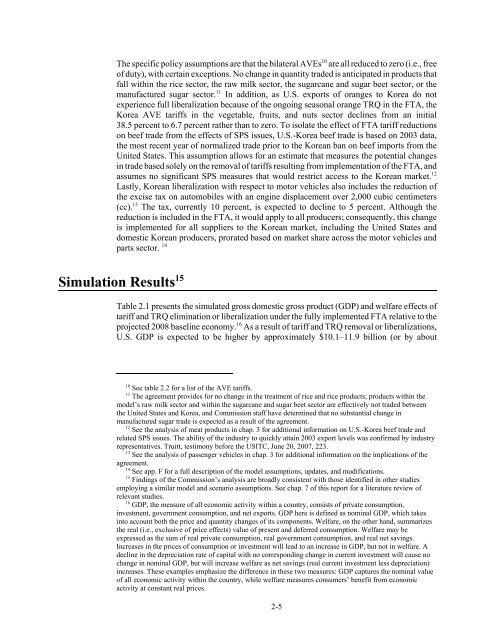U.S.-Korea Free Trade Agreement: Potential Economy-wide ... - USITC
U.S.-Korea Free Trade Agreement: Potential Economy-wide ... - USITC
U.S.-Korea Free Trade Agreement: Potential Economy-wide ... - USITC
Create successful ePaper yourself
Turn your PDF publications into a flip-book with our unique Google optimized e-Paper software.
The specific policy assumptions are that the bilateral AVEs 10 are all reduced to zero (i.e., free<br />
of duty), with certain exceptions. No change in quantity traded is anticipated in products that<br />
fall within the rice sector, the raw milk sector, the sugarcane and sugar beet sector, or the<br />
manufactured sugar sector. 11 In addition, as U.S. exports of oranges to <strong>Korea</strong> do not<br />
experience full liberalization because of the ongoing seasonal orange TRQ in the FTA, the<br />
<strong>Korea</strong> AVE tariffs in the vegetable, fruits, and nuts sector declines from an initial<br />
38.5 percent to 6.7 percent rather than to zero. To isolate the effect of FTA tariff reductions<br />
on beef trade from the effects of SPS issues, U.S.-<strong>Korea</strong> beef trade is based on 2003 data,<br />
the most recent year of normalized trade prior to the <strong>Korea</strong>n ban on beef imports from the<br />
United States. This assumption allows for an estimate that measures the potential changes<br />
in trade based solely on the removal of tariffs resulting from implementation of the FTA, and<br />
assumes no significant SPS measures that would restrict access to the <strong>Korea</strong>n market. 12<br />
Lastly, <strong>Korea</strong>n liberalization with respect to motor vehicles also includes the reduction of<br />
the excise tax on automobiles with an engine displacement over 2,000 cubic centimeters<br />
(cc). 13 The tax, currently 10 percent, is expected to decline to 5 percent. Although the<br />
reduction is included in the FTA, it would apply to all producers; consequently, this change<br />
is implemented for all suppliers to the <strong>Korea</strong>n market, including the United States and<br />
domestic <strong>Korea</strong>n producers, prorated based on market share across the motor vehicles and<br />
parts sector. 14<br />
Simulation Results 15<br />
Table 2.1 presents the simulated gross domestic gross product (GDP) and welfare effects of<br />
tariff and TRQ elimination or liberalization under the fully implemented FTA relative to the<br />
projected 2008 baseline economy. 16 As a result of tariff and TRQ removal or liberalizations,<br />
U.S. GDP is expected to be higher by approximately $10.1–11.9 billion (or by about<br />
10 See table 2.2 for a list of the AVE tariffs.<br />
11 The agreement provides for no change in the treatment of rice and rice products; products within the<br />
model’s raw milk sector and within the sugarcane and sugar beet sector are effectively not traded between<br />
the United States and <strong>Korea</strong>, and Commission staff have determined that no substantial change in<br />
manufactured sugar trade is expected as a result of the agreement.<br />
12 See the analysis of meat products in chap. 3 for additional information on U.S.-<strong>Korea</strong> beef trade and<br />
related SPS issues. The ability of the industry to quickly attain 2003 export levels was confirmed by industry<br />
representatives. Truitt, testimony before the <strong>USITC</strong>, June 20, 2007, 223.<br />
13 See the analysis of passenger vehicles in chap. 3 for additional information on the implications of the<br />
agreement.<br />
14 See app. F for a full description of the model assumptions, updates, and modifications.<br />
15 Findings of the Commission’s analysis are broadly consistent with those identified in other studies<br />
employing a similar model and scenario assumptions. See chap. 7 of this report for a literature review of<br />
relevant studies.<br />
16 GDP, the measure of all economic activity within a country, consists of private consumption,<br />
investment, government consumption, and net exports. GDP here is defined as nominal GDP, which takes<br />
into account both the price and quantity changes of its components. Welfare, on the other hand, summarizes<br />
the real (i.e., exclusive of price effects) value of present and deferred consumption. Welfare may be<br />
expressed as the sum of real private consumption, real government consumption, and real net savings.<br />
Increases in the prices of consumption or investment will lead to an increase in GDP, but not in welfare. A<br />
decline in the depreciation rate of capital with no corresponding change in current investment will cause no<br />
change in nominal GDP, but will increase welfare as net savings (real current investment less depreciation)<br />
increases. These examples emphasize the difference in these two measures: GDP captures the nominal value<br />
of all economic activity within the country, while welfare measures consumers’ benefit from economic<br />
activity at constant real prices.<br />
2-5

















